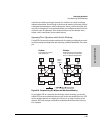
6-95
Configuring the Switch
IP Multicast (IGMP) Features—Multimedia Traffic Control
Configuring the Switch
IP Multicast (IGMP) Features—
Multimedia Traffic Control
In a network where IP multicast traffic is transmitted for various multimedia
applications, you can use the switch to reduce unnecessary bandwidth usage
on a per-port basis by configuring IGMP (Internet Group Management Proto-
col). In the factory default state (IGMP disabled), the switch forwards all IGMP
traffic to all ports, which can cause unnecessary bandwidth usage on ports
not belonging to multicast groups. Enabling IGMP allows the ports to detect
IGMP queries and report packets and manage IP multicast traffic through the
switch.
IGMP is useful in multimedia applications such as LAN TV, desktop confer-
encing, and collaborative computing, where there is multipoint communica-
tion; that is, communication from one to many hosts, or communication
originating from many hosts and destined for many other hosts. In such
multipoint applications, IGMP will be configured on the hosts, and multicast
traffic will be generated by one or more servers (inside or outside of the local
network). Switches in the network (that support IGMP) can then be config-
ured to direct the multicast traffic to only the ports where needed. If multiple
VLANs are configured, you can configure IGMP on a per-VLAN basis.
Enabling IGMP allows the ports to detect IGMP queries and report packets
and manage IP multicast traffic through the switch. If no other querier is
detected, the switch will then also function as the querier. (If you need to
disable the querier feature, you can do so through the IGMP configuration
MIB. Refer to “Changing the Querier Configuration Setting” on page 6-105.)
Note In order for IGMP service to take effect, an IP address must be configured and
active. If multiple VLANs are configured, an IP address must be configured for
the VLAN in which you are configuring IGMP. Refer to “IP Configuration” on
page 6-4.
For more information on IGMP operation, refer to “How IGMP Operates” on
page 6-100.


















